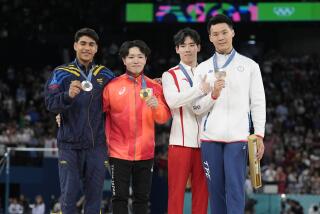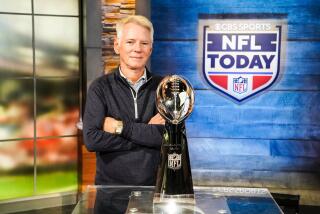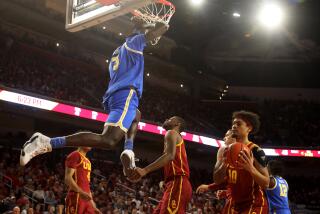Standing Up to a Sports Tradition
Oh, say can you see by the cameraâs red light. . . .
The standoff that infuriated Americaâs red, white and bluer-than-thou crowd seems to have ended, avoiding a civil rights crisis that would have given the cracked liberty bells of talk radio something to bong about until something louder and more shrill came along.
After enduring a costly one-game suspension by the National Basketball Assn. for his continued refusal to stand for the national anthem before games, Denver Nuggets star Mahmoud Abdul-Rauf, a Muslim, agreed to a compromise. He wonât sing but he will stand with his teammates and offer a personal prayer while the anthem is played. Just how many spectators boo him for this--sports jingoists are a brutal race known to insult and hiss players who do nothing more sinister than miss free throws--remains to be seen. Any hoots he does get, however, may turn to cheers whenever the long-bombing guard hits a three-pointer.
Fine. Whatever. But none of this addresses some more central questions.
If the national anthem is such a critical component of sports events in the star-spangled land of the free and the home of the brave, why is it rarely shown when those events are televised? Hey, if those TV bums donât like it here in the good old USA, they should pack up their cameras and . . .
MOVE TO CUBA!!!
Whatâs more un-American (if itâs that at all): a professional basketball player not standing for the anthem for what he says are religious reasons, or a station or network not telecasting the anthem because it prefers to run commercials instead? If the NBA can suspend Abdul-Rauf, canât the Federal Communications Commission suspend NBC?
Wait a minute. Forget suspensions. Come to think of it, why is the anthem played at sports events in the first place?
Too bad Howard Cosell canât be around when you need him.
It was Cosell who was so outspoken about this, questioning the custom of playing the anthem at sports events as if these occasions carried some special significance. What is so special? Why sing about the broad stripes and bright stars at sports events but not at the Oscars, the Emmys, the Grammys or such TV concoctions as âThe Peopleâs Choice Awardsâ? Wouldnât âthe peopleâ choose to allocate a few seconds to verbalize or warble national loyalty?
Moreover, whatâs more American than the American justice system? Yet those who watched the O.J. Simpson trial on TV may recall that at no time did Judge Lance A. Ito lead the courtroom in singing the anthem. At trials, they stand for the judge but not for a song about the flag.
At operas they sing arias, not the anthem. At houses of worship they sing hymns, not the anthem. At âThe Tonight Show With Jay Lenoâ on NBC and âLate Show With David Lettermanâ on CBS they sing rock, pop and chitchat, not the anthem.
Why should sports be different?
Something is out of sync here. The public increasingly questions the TV-driven celebrity process that irrationally promotes sports figures to the rank of beloved icon or national role model solely because of their accomplishments during the game.
At the same time, however, Americans celebrate what athletes do as some kind of national service by making singing and rising for the anthem at sports events a ritualized litmus test for being a good citizen.
*
Associating the anthem with sports is good imagery and thus good business, something the NBA itself admits by mandating that Abdul-Rauf and his fellow players stand for it. And, in his case, suspending him without pay when he didnât.
Yet even Cosell, himself an unfurled, cheerleading Old Glory during ABCâs Summer Olympics coverage in the 1980s, could find no logic for the anthem rite.
And no wonder, for immediately after the anthem in basketball, for example, players practice a narrower brand of chauvinism. They try their best to beat the droopy pants off their fellow Americans, and not necessarily in ways that live up to the most honorable traditions of nationhood.
The anthem controversy involving Abdul-Rauf epitomizes the importance of gallantly streaming symbols in popular culture, especially in sports. Another of them is found in boxing.
Regular viewers of televised boxing cannot have failed to notice the irony of ring announcers and often sports announcers wearing tuxedos in connection with an activity whose main purpose--savagely pounding an opponentâs body and seeking to rearrange the features on his face--is acknowledged to be barbaric even by many of its fans. Itâs like wearing a tux to a lynching, the formal wear attaching a touch of ritz and respectability to the gore and violence.
The other night, meanwhile, local newscasts showed footage of a monster of a heavyweight fighting in red, white and blue trunks, in effect using the flag as a fashion statement as he lumbered in the ring, prepared to fall on the stars and stripes that were surrounding his thick blubber should he get knocked to the canvas.
It gave sportscasters a good laugh.
No rocketâs red glare, no bombs bursting in air and, in contrast to Abdul-Rauf, no questioning of his Americanism.
More to Read
Go beyond the scoreboard
Get the latest on L.A.'s teams in the daily Sports Report newsletter.
You may occasionally receive promotional content from the Los Angeles Times.










